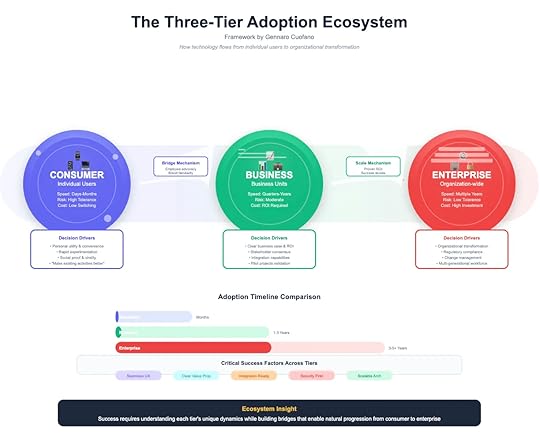The Three-Tier Adoption Ecosystem

Technologies don’t jump straight into enterprises. They diffuse through layers—first touching individuals, then business units, and only later reshaping entire organizations.
This layered model explains why some tools go viral yet fail to monetize, while others quietly build enterprise dominance over years. To win long-term, founders and strategists must master not just innovation, but the bridges between adoption tiers.
The Three Tiers of Adoption1. Consumer Tier: Utility + ConvenienceDecision Drivers: Personal utility, convenience, “make existing activities better.”Speed: Days to months.Risk tolerance: High.Cost: Low switching costs.Consumers adopt impulsively, pulled by convenience, social proof, and novelty. The decision loop is fast—users try, abandon, or evangelize within weeks.
Examples:
ChatGPT spreading among students and freelancers.Instagram filters gaining virality through immediate gratification.Key dynamic: Virality proves demand but doesn’t guarantee sustainability.
2. Business Tier: ROI + IntegrationDecision Drivers: Clear ROI, integration capabilities, stakeholder consensus, pilot project validation.Speed: Quarters to years.Risk tolerance: Moderate.Cost: ROI required.Businesses don’t adopt tools for “fun.” They require evidence: case studies, measurable ROI, and confidence that tools integrate into existing workflows.
Examples:
Mid-sized firms deploying Slack only after pilot projects prove productivity gains.Canva becoming a staple for SMBs as design ROI is proven across teams.Key dynamic: Business adoption validates commercial models. Without ROI, consumer virality stalls here.
3. Enterprise Tier: Transformation + ControlDecision Drivers: Organizational transformation, regulatory compliance, change management, multi-generational workforce adoption.Speed: 3–5+ years.Risk tolerance: Low.Cost: High investment.Enterprises only adopt when technologies can scale across thousands of employees, meet security standards, and justify massive contracts. Adoption is political, requiring executive sponsorship and cultural change.
Examples:
Microsoft Teams replacing legacy tools inside Fortune 500 firms.ServiceNow embedding itself into IT operations via compliance and integration.Key dynamic: Enterprise adoption cements category leadership. Competitors without scale mechanisms rarely catch up.
Adoption Timelines: The Compression GapConsumer adoption: Months.Business adoption: 1–3 years.Enterprise adoption: 5+ years.This creates a compression gap—the longer the leap from consumers to enterprises, the greater the risk of competitors seizing the bridge.
Case in point: Zoom moved from consumer video chats to enterprise standardization in under 18 months during COVID. That compression secured its dominance.
Bridges and MechanismsWinning technologies master bridges between tiers:
Consumer → Business: The Bridge MechanismCarried by employee advocacy and brand familiarity.Tools enter businesses via “shadow IT,” then formalize once ROI is proven.Example: Dropbox spreading from individual employees to team storage.Business → Enterprise: The Scale MechanismRequires proven ROI and success stories that can be replicated across entire organizations.Enterprises only invest when vendors show they can scale without risk.Example: Salesforce growing from departmental CRM to enterprise-wide digital transformation platform.Critical Success Factors Across TiersSeamless UX → Drives consumer virality.Clear Value Proposition → Converts businesses by proving ROI.Integration Ready → Bridges business adoption into enterprise workflows.Security First → Critical for enterprise contracts.Scalable Architecture → Ensures solutions don’t break under organizational load.Failure at any layer blocks progression. Viral apps die without ROI. SMB tools stall without enterprise readiness.
Strategic Insight: Ecosystem ThinkingThe Three-Tier Adoption Ecosystem is not just about sequencing—it’s about ecosystems.
Consumer tier tests desirability.Business tier tests viability.Enterprise tier tests scalability.Only when a technology passes all three does it transform industries.
Framework insight:
Success requires understanding each tier’s unique dynamics while building bridges that enable natural progression from consumer enthusiasm to enterprise transformation.
Most technologies never cross tiers. They go viral, then vanish. Or they thrive in SMBs, but never break into enterprise.
The winners—Zoom, Salesforce, Microsoft, OpenAI—are those that design adoption as an ecosystem, not a sequence. They deliberately build bridges, align value propositions to each tier, and compress adoption timelines.
In an environment where technology adoption accelerates, mastering the Three-Tier Adoption Ecosystem is the difference between hype and history.

The post The Three-Tier Adoption Ecosystem appeared first on FourWeekMBA.



